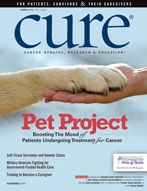With Genomic Insights, Soft Tissue Sarcoma Therapies are Evolving
The treatment paradigm for soft tissue sarcomas is changing as the condition is becoming better understood.
SARCOMAS WERE NAMED for what they had in common: They are all tumors of connective and so-called “soft” tissues, including muscle, cartilage, bone and fat. But as we have improved our understanding of the molecular biology of tumors that arise in these tissues, we now know that sarcomas are a very diverse set of cancers that require different treatment approaches.
In this issue of CURE magazine, we take a close look at what soft tissue sarcomas are, and how treatments for these conditions are advancing. Our feature article points out that, despite the differences between these tumors, there are certain commonalities in the genetic and environmental features that allow them to grow. For example, the rare inherited mutation in the p53 gene known as Li-Fraumeni syndrome can give rise to several types of sarcomas, as well as to breast, brain and hematological malignancies; exposure to radiation can also cause these and other cancers. Although the age distribution is quite broad, certain types of sarcomas are seen preferentially in younger patients, and these tend to be more sensitive to chemotherapy.
Treatment for sarcomas has long been focused around surgery, chemotherapy and radiation, but the sequence of treatments, and the techniques or drugs used, are quite distinct. Moreover, genomic alterations in these tumors are pointing to new opportunities for treatments, some of which are unique to certain subtypes. Most notable are gastrointestinal stromal tumors (GISTs), which were originally considered soft tissue sarcomas but have now been moved out of that category. GISTs — which are commonly seen in the abdomen, often diagnosed at advanced stages and resistant to chemotherapy — used to be considered aggressive and untreatable as a result of these factors. But the discovery that KIT gene mutations are common in GISTs led to the use of biological drugs that target the mutant protein encoded by that gene. It turned out that GISTS are quite sensitive to these drugs, and this strategy has greatly improved the cure rate for this condition. Now, scientists are testing biological agents as treatments for a variety of sarcomas, and have also explored two newer chemotherapy agents initially derived from marine micro-organisms, which have been approved by the FDA.
Any given type of sarcoma is relatively rare, and therefore certain steps are important for its diagnosis and management. First, confirmation of the pathology and possibly protein and genomic analysis of tumor tissue may be needed. This is best done by an experienced pathology department, so local hospitals will often collaborate with larger centers or universities to help establish a sarcoma’s subtype. In addition, imaging may be needed in order to properly stage a sarcoma and plan for surgery, if that procedure is an option.
Most importantly, a multidisciplinary team that typically includes medical, surgical and radiation oncologists familiar with sarcomas should review each case. This may not be possible in many areas of the country, where oncologic expertise may be scarce, so outreach, referrals or even remote consultations are key options for patients and their physicians to exercise. We hope that our update on this group of diseases will inform and help provide direction for those affected by sarcoma, as well as for their families and other loved ones.
DEBU TRIPATHY, MDEditor-in-ChiefProfessor of MedicineChair, Department of Breast Medical OncologyThe University of Texas MD Anderson Cancer Center
